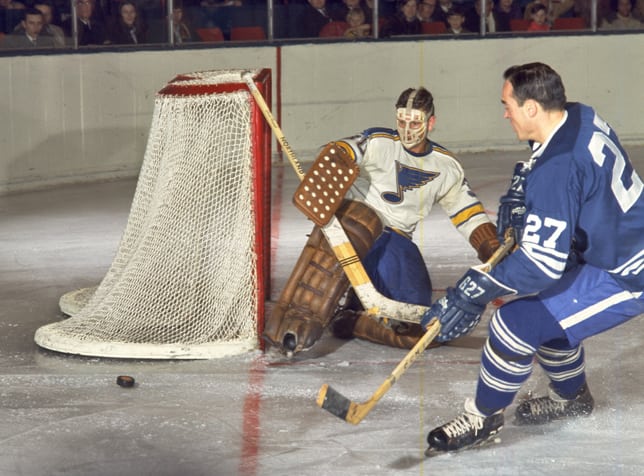
In Memoriam: Seth Martin – Vladislav Tretiak's hockey hero
He played just one one season in the NHL, but Seth Martin made a lasting impact on the hockey world and inspired one of the game's greatest goalies.
 In Memoriam: Seth Martin – Vladislav Tretiak's hockey hero
In Memoriam: Seth Martin – Vladislav Tretiak's hockey heroBy Greg Oliver
He's in the International Ice Hockey Federation Hall of Fame, won two Allan Cups, made Glenn Hall’s first face mask and inspired Vladislav Tretiak. Yet because he only played a single season in the NHL, many fans are unaware of the importance of Seth Martin.
The native of Rossland, B.C., who died Sept. 6, at the age of 81, is most associated with the Trail (B.C.) Smoke Eaters, the perennial senior powerhouse of the 1950s and 1960s.
Like a lot of goalies, he was put in net because he was the smallest player.
“It wasn’t by choice at that particular time," Martin said in 2012. "I got to like the position. You certainly watch other people play goal, and certain things they do were attractive to you and you try them at different points in your hockey career. Some of them work and some of them don’t. I think eventually you have your own style and you develop that.”
He joined Trail for 1953-54 and was there for a decade until the team disbanded. He landed with his hometown Rossland Warriors, where he would also serve as a general manager.
But Martin’s legend came when playing overseas.
The Trail Smoke Eaters lost the 1960 Allan Cup to the Chatham Maroons, but were chosen to represent their country at the 1961 World Championships in Switzerland. (Trail would win the Cup in 1962 and Martin won another in 1970 with the Spokane Jets, the first U.S. squad to be the top senior amateur team in Canadian hockey.)
In Scott Young’s book War On Ice, about Canada in international hockey, Martin talked about mastering the Soviet Union, which had won two World Championships in the 1950s and dominated the next two decades.
“I finally figured, well, he’s not going to shoot from what I’d think was a good shot," Martin said. "He’s going to pass it off. Eventually I had to play goal the wrong way, as far as I was concerned. They would just not shoot the puck from where they should have shot from.”
A young Tretiak took notice.
“I had also found a hero in hockey, a Canadian goaltender named Seth Martin,” he wrote in his autobiography.
Martin didn’t actually meet the Russian superstar until 1997, when he was inducted into the IIHF Hall of Fame.
“We talked a lot," Martin said. "He always says, ’Oh, you were my 'ee-dol’ for idol, that kind of thing. It felt nice to get compliments from someone like that.”
Martin was the first to wear a mask overseas. When he returned to Czechoslovakia, almost all the goalies were masked. He was never shy about sharing the secrets of his cage.
“I had sent a couple of masks over in ’61, two to Czech and one to Russia,” Martin said. “Then I saw a few more masks later that were almost identical to the ones I made. It was strange. They knew more about me and my masks than I did probably!”
Defenseman Marshall Johnston was Martin’s teammate in the 1964 Olympics, which finished fourth. He saw first-hand Martin’s legend at exhibition games in the Czechoslovakia.
“Seth comes onto the ice, and I couldn’t figure out what the crowd was chanting, but the chant was, ʽMart-een, Mart-een,’ " Johnston said. "The Czech crowd was chanting for him. Of course, he’d been over there before with Trail. They were well aware of him.”
Electing to go pro, Martin joined the 1967-68 St. Louis Blues and partnered with Hall. Martin, wearing No. 30, played 30 games and appeared in two playoff games.
“When I was in St. Louis, Glenn didn’t have anything to wear and he asked me if I would consider making a mask for him. I said sure,” Martin recalled. “I didn’t mind that at all. I made it right in the St. Louis Blues’ arena’s maintenance shop.”
Martin came to a tough decision after the season. It would be 210 games to get to an NHL pension. He’d already been a firefighter at the Cominco plant in Trail and had 12 years invested into that pension plan. He went back to B.C. and served another 24 years.
Over the past six years, Martin faced numerous health challenges, battling off prostate cancer and then facing multiple myeloma, a non-curable bone cancer. He was visiting in Idaho when he suffered a heart attack and died a week later. Martin is survived by his wife, Bev, and three daughters.
For more great profiles, news and views from the world of hockey, subscribe to The Hockey News magazine.

We’d love to hear your thoughts! What did you think of the story? Drop a comment below and share your perspective—your voice matters, and we can’t wait to read what you have to say!
